Abstract
Lightcurves for 16 main-belt asteroids were obtained at the Center for Solar System Studies-Palmer Divide Station (CS3-PDS) from 2015 December into 2016 April.
CCD photometric observations of 16 main-belt asteroids were made at the Center for Solar System Studies-Palmer Divide Station (CS3-PDS) from 2015 December into 2016 April. Table I lists the telescope/CCD camera combinations used for the observations. All the cameras use CCD chips from the KAF blue-enhanced family and so have essentially the same response. The pixel scales for the combinations range from 1.24-1.60 arcsec/pixel.
Table I.
List of CS3-PDS telescope/CCD camera combinations.
| Desig | Telescope | Camera |
|---|---|---|
| Squirt | 0.30–m f/6.3 Schmidt–Cass | ML–1001E |
| Borealis | 0.35–m f/9.1 Schmidt–Cass | STL–1001E |
| Eclipticalis | 0.35–m f/9.1 Schmidt–Cass | ML–1001E |
| Australius | 0.35–m f/9.1 Schmidt–Cass | STL–1001E |
| Zephyr | 0.50–m f/8.1 R–C | FLI–1001E |
All lightcurve observations were unfiltered since a clear filter can result in a 0.1-0.3 magnitude loss. The exposure duration varied depending on the asteroid’s brightness and sky motion. Guiding on a field star sometimes resulted in a trailed image for the asteroid.
Measurements were made using MPO Canopus. If necessary, an elliptical aperture with the long axis parallel to the asteroid’s path was used. The Comp Star Selector utility in MPO Canopus found up to five comparison stars of near solar-color for differential photometry. Catalog magnitudes were usually taken from the APASS catalog (Henden et al., 2009). When there were insufficient stars, the MPOSC3 catalog was used. This catalog is based on the 2MASS catalog (http://www.ipac.caltech.edu/2mass) but with magnitudes converted from J-K to BVRI using formulae developed by Warner (2007). The nightly zero points for both catalogs have been found to be generally consistent to about ± 0.05 mag or better, but on occasion are as large as 0.1 mag. There is a systematic offset between the two catalogs so, whenever possible, the same catalog is used throughout the observations for a given asteroid. Period analysis is also done using MPO Canopus, which implements the FALC algorithm developed by Harris (Harris et al., 1989).
In the plots below, the “Reduced Magnitude” is Johnson V as indicated in the Y-axis title. These are values that have been converted from sky magnitudes to unity distance by applying −5*log (rΔ) to the measured sky magnitudes with r and Δ being, respectively, the Sun-asteroid and Earth-asteroid distances in AU. The magnitudes were normalized to the given phase angle, e.g., alpha(6.5°), using G = 0.15, unless otherwise stated. The X-axis is the rotational phase ranging from −0.05 to 1.05.
If the plot includes an amplitude, e.g., “Amp: 0.65”, this is the amplitude of the Fourier model curve and not necessarily the adopted amplitude for the lightcurve. The value is meant only to be a quick guide.
For the sake of brevity, only some of the previously reported results may be referenced in the discussions on specific asteroids. For a more complete listing, the reader is directed to the asteroid lightcurve database (LCDB; Warner et al., 2009). The on-line version at http://www.minorplanet.info/lightcurvedatabase.html allows direct queries that can be filtered a number of ways and the results saved to a text file. A set of text files of the main LCDB tables, including the references with bibcodes, is also available for download. Readers are strongly encouraged to obtain, when possible, the original references listed in the LCDB for their work.
The period shown in the lightcurve (7.0 ± 0.82 h) is just one of many that fit the data. Assuming a bimodal lightcurve, the best solution is an indefinite one of P ≥ 12 h and A ≥ 0.2 mag.
344 Desiderata.
This is an inner main-belt asteroid. Behrend (2004, 2005, 2012) found a period near 10.75 hours. The results from the CS3-PDS observations are in good agreement.
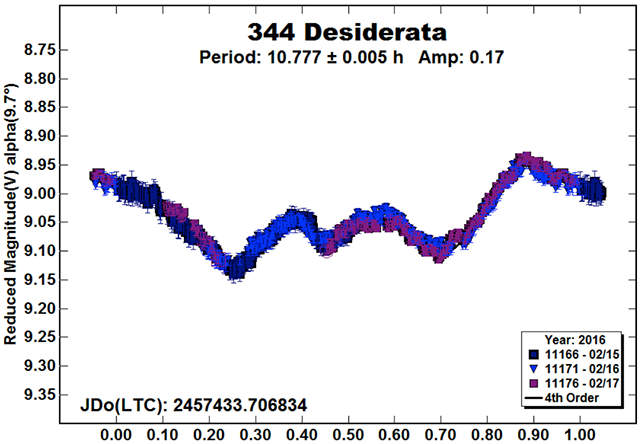
347 Pariana.
The period for this M-type (Tholen, 1984) Eunomia member has been reported several times in the page, e.g., Majcen and Wetterer (1999; 4.0529 h) and Behrend (2012, 4.0524 h). The PDS period of 4.053 ± 0.001 h is consistent with the previous results.

1196 Sheba.
Binzel (1987) reported a period of 7.08 h for this middle main-belt asteroid. Stephens (2004) found a period of 6.32 hours based on an extended data set obtained over three nights in 2004 April. The PDS data set contained 395 data points obtained over five consecutive nights in 2016 March. Analysis of the PDS data found a period of 6.317 ± 0.005 h and amplitude of 0.20 mag. The period verifies the one found by Stephens.
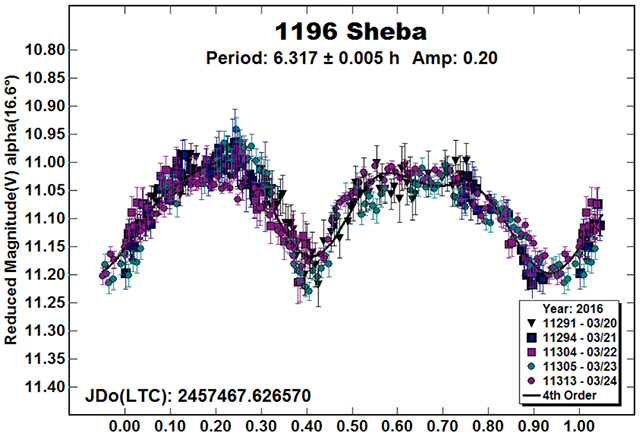
1453 Fennia.
This is a known Hungaria binary (Warner et al., 2007) that was further confirmed in 2008 (Warner et al., 2008b) and 2011 (Higgins et al., 2011). The primary’s rotation period is 4.4121 h and the satellite’s orbital period is almost exactly 23 hours. The latter makes it essentially impossible for a single station to cover the secondary lightcurve and look for mutual events.



The “No Sub” plot shows the lightcurve using a single-period search. When looking for the primary period, the secondary period was forced to between 23-24 hours, with the resulting Fourier curve subtracted to find the primary period. Forcing the range was required because the lack of coverage led to a number of solutions for the secondary period. Even though incorrect by about 0.5 hours, subtracting the secondary period led to a primary period of 4.412 h, which agrees with earlier results.
2048 Dwornik.
This Hungaria asteroid was observed by the author at four previous apparitions (Warner 2008d, 2011, 2013c, 2014a) with the last three leading to periods of about 3.7 hours. The period of 8.65 h Warner (2008d) was eventually ruled out by the subsequent results.
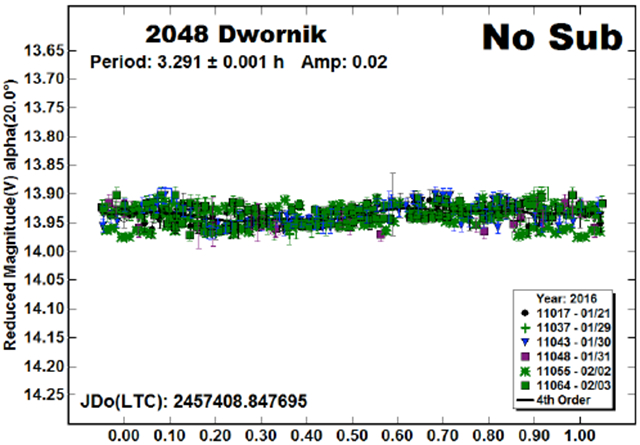

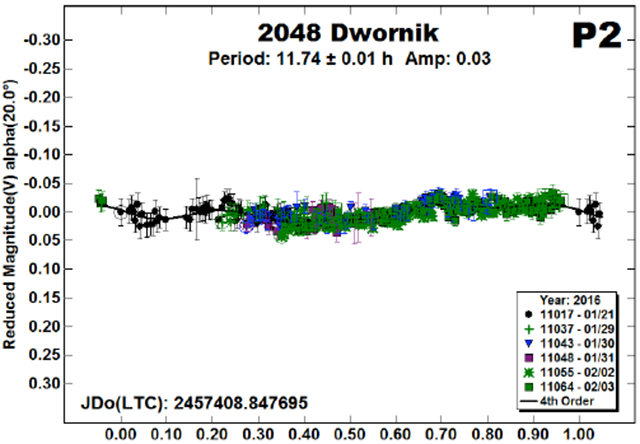
Analysis of the 2016 data seemed to indicate two low-amplitude periods (“No Sub”). A dual period search in MPO Canopus found a primary period (“P1”) of 3.780 h, in good agreement with previous results. The secondary period (“P2”) is close to, but not exactly, an integer multiple of P1 and so may be an artifact of the Fourier analysis.
The data from the previous apparitions were re-examined for dual periods. Surprisingly, the 2008 data showed the best indication, with P1 = 3.709 ± 0.002 and P2 = 11.80 ± 0.02 h, both with amplitudes of A < 0.05 mag. There were no indications in the 2011 data set, which had a primary amplitude of 0.16 mag. The larger amplitude would indicate a more equatorial view. A presumptive satellite’s orbit would be near the equatorial plane of the asteroid and so mutual event would seem more likely. Absence of proof is not proof of absence, however. This asteroid warrants close examination at future apparitions.
2333 Porthan.
Waszczak (2015) and Behrned (2003) both reported periods of about 28 hours for this member of the Eunomia group. Due to equipment problems, only two nights of data were obtained. In the lightcurve presented here, the data have been forced to a period near the earlier results. The slopes of the ascending and descending branch are consistent with the adopted period. In addition, a search for the half-period monomodal solution found a reasonably good fit at 14.2 h.
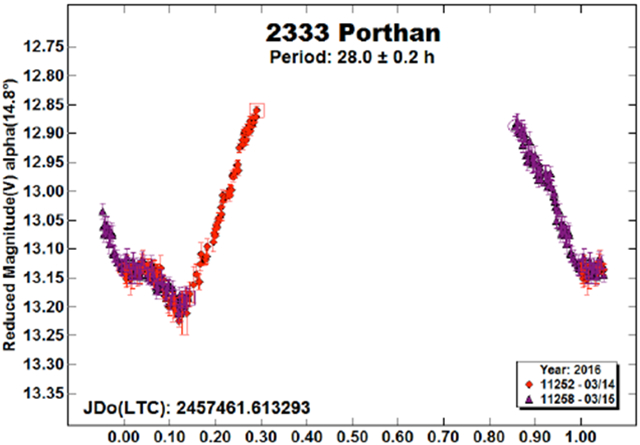
3069 Heyrovsky.
This appears to be the first reported period for this inner main-belt asteroid, which was in the field of a planned target for only one night. However the data nearly cover the full period and so the solution is considered reasonably secure. The WISE survey (Mainzer et al., 2011) reported a diameter of 4.7 km and a relatively high albedo for an inner main-belt asteroid of pv = 0.3497. This was based on H = 13.4. Using the algorithm from Harris and Harris (1997) to correct albedo based on a new value of for thermal observation and the current value of H = 13.6, the albedo is reduced to 0.2977. This puts the value just more than one sigma over the average value for S-type asteroid found by Warner et al. (2009)

6310 Jankonke.
The 2015-16 apparition was the fifth one at which the author observed this Hungaria asteroid. The periods that were found varied slightly, but significantly: Warner (2005, 3.042 h; 2008c, 3.080 h; 2011, 3.0433 h; 2013b, 3.076 h). These variations are most likely attributed to differences of quality in the data sets and the natural change in synodic period as an asteroid approaches and then moves away from opposition.

6859 Datemasamune.
When it comes to finding a period, this Hungaria asteroid has proved to be very difficult over the years: Warner (2006, 12.95 h; 2010a, 22.1 h; 2011, 86.1 h). The mystery may be (almost) finally solved. Analysis of the PDS data obtained in 2016 February and March found one of two possible periods depending on whether a monomodal or bimodal lightcurve is adopted.
As covered by Harris et al. (2014), low-amplitude lightcurves at low phase angles can be almost any modality and so a bimodal solution cannot be guaranteed. Despite that, the longer, bimodal solution of 5.2879 h is adopted for this paper with the acknowledgement that the shorter period cannot be discarded out-of-hand.


13478 Fraunhofer.
There were no previous entries in the asteroid lightcurve database (LCDB) for this Hungaria asteroid. The solution should be considered tentative, although a monomodal half-period solution does support the period given here.
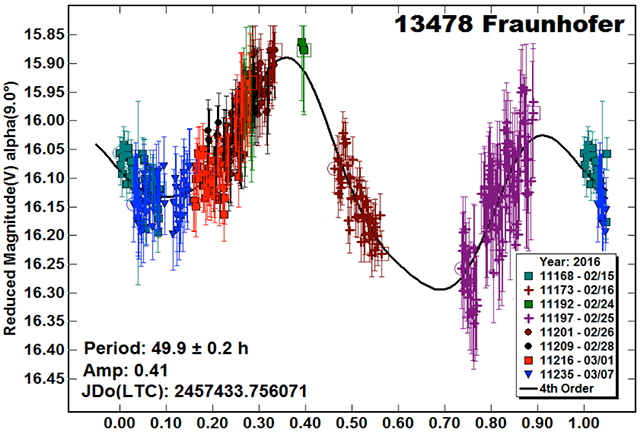
16669 Rionuevo.
The period of 4.951 h found from the 2016 PDS data is essentially the same as reported in previous works: Warner (2010b, 4.951 h; 2013c, 4.953).
A preliminary pole position (ecliptic coordinates) of λ = 338°, β = +12°, Psidereal = 4.952415 (Warner et al., 2014b) was found based on the dense lightcurve data from the two previous apparitions and sparse data from NEO surveys. The solution was rated Q = 3 on a scale of 1 to 5, meaning that the sense of rotation (prograde vs. retrograde) was reasonably determined but the ecliptic coordinates were very uncertain. The modeling will be done anew, adding the new data set.

(25332) 1999 KK6.
Two of the previous results by the author are both near 2.453 h (Warner 2008a, 2013a), matching the period found from the 2016 data. Warner (2013a) reported that there were small indications of a satellite with an orbital period of about 29 or 16 hours. There were no indications a satellite in 2016.

27776 Cortland.
The author observed this Hungaria in 2009 and 2012 (2013b) where periods of about 2.610 h were found.

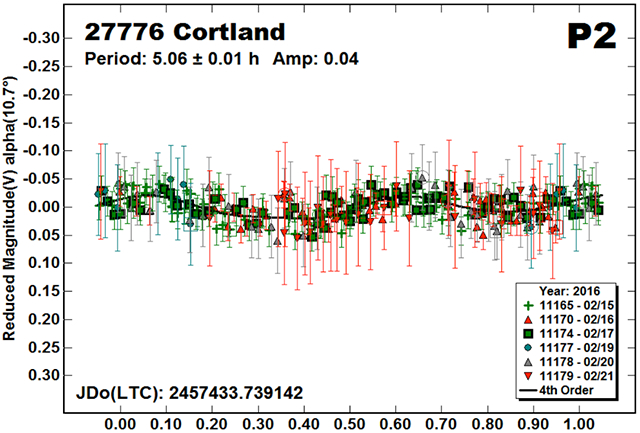
Unlike at earlier apparitions, the 2016 PDS data showed indications of two periods, the first (“P1”) matching those found earlier. The secondary period (“P2”), if substantiated, might indicate the rotation of a satellite that is not tidally-locked to its orbital period. In this case, the separation between the two bodies would be substantial in terms of the primary diameter (see, e.g., Jacobson et al., 2014; Pravec et al., 2014, 2016).
33319 Kunqu.

This appears to be the first reported period for this Hungaria member. There are signs of tumbling (see Pravec et al., 2005, 2014) since the lightcurve did not repeat itself and some sessions seem “out of place” or have the wrong slope.
(56482) 2000 GY115.
There were no prior entries in the LCDB for 2000 GY115, an inner main-belt asteroid.

(58155) 1988 VD.
This Hungaria may be another example of a wide asynchronous binary (see, e.g., Jacobson et al., 2014; Pravec et al., 2014, 2016) or it could be a low-level tumbler (Petr Pravec, private communications; see Pravec et al., 2005, 2014). There are not enough data to establish it’s pedigree with certainty.


The “No Sub” lightcurve show the result of a single period search in MPO Canopus. The period spectrum shows a strong solution at P1 = 7.094 h with a few others that are not harmonically related. A dual-period search in MPO Canopus found a strong candidate at P2 = 8.018 h. Longer solutions in the P2 period spectrum are harmonically related to P2. At the very least, subtracting P2 from the dataset significantly improved the fit for P1.



If the object is a wide binary, seeing mutual events will be highly unlikely. If tumbling, then a more extensive data set is required. In either case, it should be obtained by several observers at widely-spaced longitudes.
Table II.
Observing circumstances.
| Number | Name | 2016 mm/dd | Pts | Phase | LPAB | BPAB | Period | P.E. | Amp | A.E. | Group |
|---|---|---|---|---|---|---|---|---|---|---|---|
| 344 | Desiderata | 02/15–02/17 | 879 | 9.7,9.4 | 159 | 22 | 10.777 | 0.005 | 0.17 | 0.01 | MB–I |
| 347 | Pariana | 01/27–01/31 | 111 | 6.0,7.4 | 121 | 10 | 4.053 | 0.001 | 0.48 | 0.02 | EUN |
| 1196 | Sheba | 03/20–03/24 | 395 | 16.6,17.3 | 131 | 13 | 6.317 | 0.005 | 0.20 | 0.02 | MB–M |
| 1453 | Fennia | 04/01–04/05 | 165 | 31.2,31.3 | 122 | 21 | P4.412 | 0.002 | 0.19 | 0.02 | H |
| 2048 | Dwornik | 01/21–02/03 | 351 | 20.0,13.6 | 154 | −7 | P3.780 | 0.002 | 0.02 | 0.01 | H |
| 2333 | Porthan | 03/14–03/15 | 227 | 14.9,15.2 | 149 | 14 | 28.0 | 0.2 | 0.38 | 0.05 | EUN |
| 3069 | Heyrovsky | 02/13–02/13 | 76 | 11.3,11.3 | 117 | −2 | 6.6 | 0.2 | 0.23 | 0.02 | MB–I |
| 6310 | Jankonke | 1512/19–12/26 | 112 | 27.1,25.5 | 130 | 20 | 3.078 | 0.002 | 0.18 | 0.02 | H |
| 6859 | Datemasamune | 02/20–03/20 | 538 | 19.7,11.7,12.0 | 179 | 13 | 5.2879 | 0.0005 | 0.06 | 0.01 | H |
| 13478 | Fraunhofer | 02/15–03/07 | 418 | 9.0,20.3 | 134 | 0 | 49.9 | 0.2 | 0.45 | 0.04 | H |
| 16669 | Rionuevo | 04/01–04/05 | 167 | 16.7,16.0 | 202 | 27 | 4.951 | 0.005 | 0.47 | 0.02 | H |
| 25332 | 1999 KK6 | 12/31–01/13 | 252 | 25.5,28.6 | 62 | −19 | 2.4531 | 0.0002 | 0.1 | 0.01 | H |
| 27776 | Cortland | 02/15–02/21 | 250 | 10.7,7.7 | 161 | −6 | 2.615 | 0.002 | 0.07 | 0.01 | H |
| 33319 | Kunqu | 01/25–02/06 | 715 | 10.3,16.6 | 115 | 13 | 105 | 5 | 0.9 | 0.1 | H |
| 56482 | 2000 GY115 | 02/12–02/17 | 192 | 3.7,3.6,4.0 | 144 | −7 | 51.5 | 0.5 | 0.75 | 0.05 | MB–I |
| 58155 | 1988 VD | 03/25–03/31 | 278 | 26.2,27.4 | 155 | 22 | PT7.093 | 0.005 | 0.36 | 0.03 | H |
Observations in 2013.
Observations in 2015.
period of primary in binary system.
dominant period of a tumbler.
The phase angle (α) is given at the start and end of each date range, unless it reached a minimum, which is then the second of three values. If a single value is given, the phase angle did not change significantly and the average value is given. LPAB and BPAB are each the average phase angle bisector longitude and latitude, unless two values are given (first/last date in range). The Group column gives the orbital group to which the asteroid belongs. The definitions and values are those used in the LCDB (Warner et al., 2009). H = Hungaria; MB–I/M/O = Main-belt inner/middle/outer. EUN = Eunomia
Acknowledgements
Funding for PDS observations, analysis, and publication was provided by NASA grant NNX13AP56G. Work on the asteroid lightcurve database (LCDB) was also funded in part by National Science Foundation grant AST-1507535.
This research was made possible in part based on data from CMC15 Data Access Service at CAB (INTA-CSIC) and the AAVSO Photometric All-Sky Survey (APASS), funded by the Robert Martin Ayers Sciences Fund. (http://svo2.cab.inta-csic.es/vocats/cmc15/).
This publication makes use of data products from the Two Micron All Sky Survey, which is a joint project of the University of Massachusetts and the Infrared Processing and Analysis Center/California Institute of Technology, funded by the National Aeronautics and Space Administration and the National Science Foundation. (http://www.ipac.caltech.edu/2mass/)
References
- Binzel RP (1987). “A photoelectric survey of 130 asteroids.” Icarus 72, 135–208. [Google Scholar]
- Behrend R (2003, 2004, 2005, 2012) Observatoire de Geneve web site, http://obswww.unige.ch/~behrend/page_cou.html
- Harris AW, Young JW, Scaltriti F, Zappala V (1984). “Lightcurves and phase relations of the asteroids 82 Alkmene and 444 Gyptis.” Icarus 57, 251–258. [Google Scholar]
- Harris AW, Young JW, Bowell E, Martin LJ, Millis RL, Poutanen M, Scaltriti F, Zappala V, Schober HJ, Debehogne H, Zeigler KW (1989). “Photoelectric Observations of Asteroids 3, 24, 60, 261, and 863.” Icarus 77, 171–186. [Google Scholar]
- Harris AW, Harris AW (1997). “On the Revision of Radiometric Albedos and Diameters of Asteroids.” Icarus 126, 450–454. [Google Scholar]
- Harris AW, Pravec P, Galad A, Skiff BA, Warner BD, Vilagi J, Gajdos S, Carbognani A, Hornoch K, Kusnirak P, Cooney WR, Gross J, Terrell D, Higgins D, Bowell E, Koehn BW (2014). “On the maximum amplitude of harmonics on an asteroid lightcurve.” Icarus 235, 55–59. [Google Scholar]
- Henden AA, Terrell D, Levine SE, Templeton M, Smith TC, Welch DL (2009). http://www.aavso.org/apass
- Higgins D, Oey J, Pravec P (2011). “Period Determination of Binary Asteroid Targets Observed at Hunters Hill Observatory: May-September 2009.” Minor Planet Bull. 38, 46–49. [Google Scholar]
- Jacobson SA, Scheeres DJ, McMahon J (2014). “Formation of the Wide Asynchronous Binary Asteroid Population.” Astron. J. 780:A60. [Google Scholar]
- Majcen S, Wetterer CJ. (1999). “CCD Photometry of Asteroid 347 Pariana at the US Air Force Academy Observatory.” Minor Planet Bull. 26, 29. [Google Scholar]
- Mainzer A, Grav T, Bauer J, Masiero J, McMillan RS, Cutri RM, Walker R, Wright E, Eisenhardt P, Tholen DJ, Spahr T, Jedicke R, Denneau L, DeBaun E, Elsbury D, Gautier T, Gomillion S, Hand E, Mo W, Watikins J, Wilkins A, Bryngelson GL, Del Pino Molia A, Desai S, Gomez Camus M, Hidalgo SL, Konstantopoulos I, Larsen JA, Maleszewski C, Malkan MA, Mauduit J-C, Mullan BL, Olszewski EW, Pforr J, Saro A, Scotti JV, Wasserman LH (2011). “NEOWISE observations of near-Earth objects: Preliminary results.” Ap. J. 743, A156. [Google Scholar]
- Pravec P, Vokrouhlicky D, Polishook D, Scheeres DJ, Harris AW, Galad A, Vaduvescu O, Pozo F, Barr A, Longa P, and 16 coauthors (2010). “Formation of asteroid pairs by rotational fission,” Nature 466, 1085–1088. [DOI] [PubMed] [Google Scholar]
- Pravec P, Scheirich P, Durech J, Pollock J, Kusnirak P, Hornoch K, Galad A, Vokrouhlicky D, Harris AW, Jehin E, Manfroid J, Opitom C, Gillon M, Colas F, Oey J, Vrastil J, Reichart D, Ivarsen K, Haislip J, LaCluyze A (2014). “The tumbling state of (99942) Apophis.” Icarus 233, 48–60. [Google Scholar]
- Pravec P, Scheirich P, Kušnirák P, Hornoch K, Galád A, Naidu SP, Pray DP, Világi J, Gajdoš Š, Kornoš L, Krugly, Yu N, Cooney WR, Gross J, Terrell D, Gaftonyuk N, Pollock J, Husárik M, Chiorny V, Stephens RD, Durkee R, Reddy V, Dyvig R, Vraštil J, Žižka J, Mottola S, Hellmich S, Oey J, Benishek V, Kryszczyńska A, Higgins D, Ries J, Marchis F, Baek M, Macomber B, Inasaridze R, Kvaratskhelia O, Ayvazian V, Rumyantsev V, Masi G, Colas F, Lecacheux J, Montaigut R, Leroy A, Brown P, Krzeminski Z, Molotov I, Reichart D, Haislip J, LaCluyze A. (2016). “Binary asteroid population. 3. Secondary rotations and elongations.” Icarus 267, 267–295. [Google Scholar]
- Stephens RD (2004). “Photometry of 1196 Sheba, 1341 Edmee, 1656 Suomi, 2577 Litva, and 2612 Kathryn.” Minor Planet Bull. 31, 95–97. [Google Scholar]
- Tholen DJ (1984). “Asteroid taxonomy from cluster analysis of Photometry.” Doctoral Thesis. Univ. Arizona, Tucson. [Google Scholar]
- Warner BD (2005). “Asteroid lightcurve analysis at the Palmer Divide Observatory - winter 2004–2005.” Minor Planet Bull. 32, 54–58. [PMC free article] [PubMed] [Google Scholar]
- Warner BD (2006). “Asteroid lightcurve analysis at the Palmer Divide Observatory - February - March 2006.” Minor Planet Bull. 33, 82–84. [PMC free article] [PubMed] [Google Scholar]
- Warner BD, Harris AW, Pravec P, Stephens RD, Pray D, Cooney W, Gross J, Terrell D, Gajdos S, Galad A, Krugly Yu. (2007). “(1453) Fennia.” CBET 1150. [Google Scholar]
- Warner BD (2008a). “Asteroid Lightcurve Analysis at the Palmer Divide Observatory: September-December 2007.” Minor Planet Bull. 35, 67–71. [PMC free article] [PubMed] [Google Scholar]
- Warner BD, Harris AW, Pravec P, Stephens RD, Pray DP, Cooney WR Jr., Gross J, Terrell D, Gajdos S, Galad A, Krugly Yu. (2008b). “1453 Fennia: A Hungaria Binary.” Minor Planet Bull. 35, 73–74. [Google Scholar]
- Warner BD (2008c). “Asteroid Lightcurve Analysis at the Palmer Divide Observatory: December 2007 - March 2008.” Minor Planet Bull. 35, 95–98. [Google Scholar]
- Warner BD (2008d). “Asteroid Lightcurve Analysis at the Palmer Divide Observatory: February-May 2008.” Minor Planet Bull. 35, 163–167. [PMC free article] [PubMed] [Google Scholar]
- Warner BD, Harris AW, Pravec P (2009). “The Asteroid Lightcurve Database.” Icarus 202, 134–146. Updated 2016 Feb. http://www.minorplanet.info/lightcurvedatabase.html. [Google Scholar]
- Warner BD (2010a). “Asteroid Lightcurve Analysis at the Palmer Divide Observatory: 2009 June-September.” Minor Planet Bull. 37, 24–27. [PMC free article] [PubMed] [Google Scholar]
- Warner BD (2010b). “Asteroid Lightcurve Analysis at the Palmer Divide Observatory: 2009 September-December.” Minor Planet Bull. 37, 57–64. [PMC free article] [PubMed] [Google Scholar]
- Warner BD (2011). “Asteroid Lightcurve Analysis at the Palmer Divide Observatory: 2011 March-July.” Minor Planet Bull. 38, 190–195. [PMC free article] [PubMed] [Google Scholar]
- Warner BD (2013a). “Rounding Up the Unusual Suspects.” Minor Planet Bull. 40, 36–42. [PMC free article] [PubMed] [Google Scholar]
- Warner BD (2013b). “Asteroid Lightcurve Analysis at the Palmer Divide Observatory: 2012 September-2013 January.” Minor Planet Bull. 40, 71–80. [PMC free article] [PubMed] [Google Scholar]
- Warner BD (2013c). “Asteroid Lightcurve Analysis at the Palmer Divide Observatory: 2013 January–March.” Minor Planet Bull. 40, 137–145. [PMC free article] [PubMed] [Google Scholar]
- Warner BD (2014a). “Asteroid Lightcurve Analysis at CS3-Palmer Divide Station: 2014 March-June.” Minor Planet Bull. 41, 235–241. [PMC free article] [PubMed] [Google Scholar]
- Warner BD, Harris AW, Stephens RD, Coley D (2014b). “Spin Axis Distribution of the Hungaria Asteroids via Lightcurve Inversion.” AAS DPS meeting #46, id.509.12. [Google Scholar]
- Waszczak A, Chang C-K, Ofek EO, Laher R, Masci F, Levitan D, Surace J, Cheng Y-C, Ip W-H, Kinoshita D, Helou G, Prince TA, Kulkarni S (2015). “Asteroid Light Curves from the Palomar Transient Factory Survey: Rotation Periods and Phase Functions from Sparse Photometry.” Astron. J. 150, A75. [Google Scholar]


